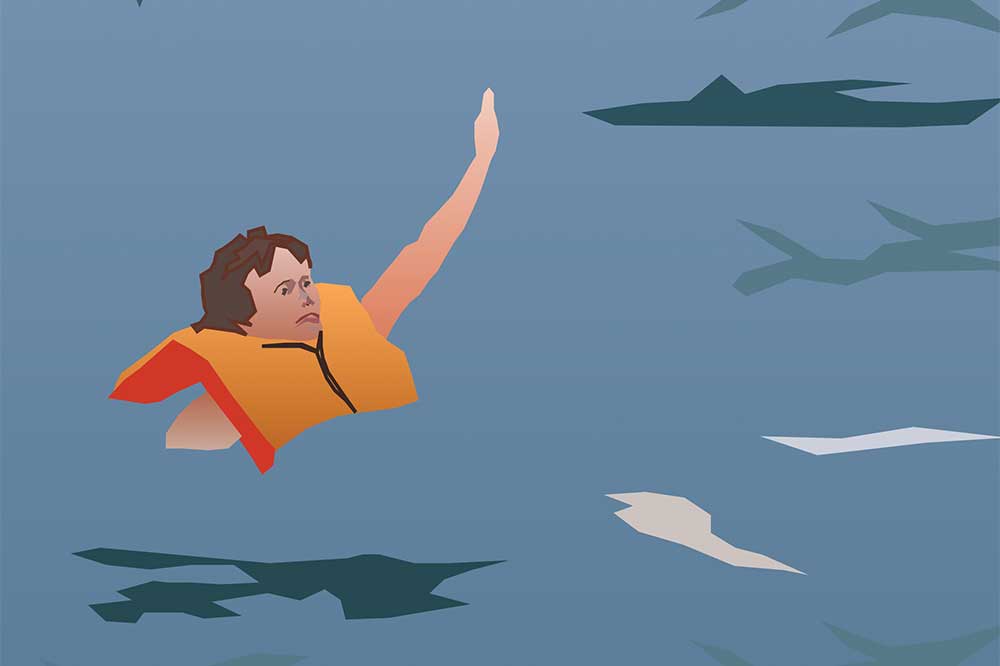How to respond to crew overboard under sail
• Keep the MOB in sight
• Tack into the heave-to position, do not adjust the headsail sheets
• If under spinnaker, alter course to windward and haul sail down immediately
• Throw buoyancy to the MOB
• Mark MOB with dan buoy
• If within earshot of MOB reassure them you are manoeuvring into recovery position• Steer onto a beam/broad reach and sail away• Sail for about 5 or 6 boat lengths• Tack, aiming the leeward side of the yacht at the MOB
• Let out the headsail and mainsail sheets until the main flaps
• Keep the angle of approach as a close reach, so the sails can be powered and de-powered under full control
• Use one sail only in breezy conditions
• Approach the MOB slowly. Don’t be tempted to approach too quickly
• Pick up the MOB to leeward, aft of the mast
• In light conditions, approach MOB to windward and drift down towards casualty so they can be recovered on leeward side
(taken from the Safe Skipper app for iPhone, iPad & Android)
Cleaning & polishing gelcoat topsides
The gelcoat topsides of a GRP boat can be pampered and restored to their former glory relatively easily when it is ashore. Gelcoat is only a very thin outer layer of the hull, often less than 1mm thick, so you should avoid cleaning it with highly abrasive cleaners, or an-ything that could potentially damage its surface.
Fractures, sprains and dislocations at sea
Moving about a boat at sea often results in a few knocks and bruises, but if a crew member has a fall or major bump and is in serious pain, they should be examined and treated accordingly.
Seized fixings and fastenings
Maintaining a boat can be a rewarding experience but at times it can also be frustrating. A prime example of this is when you come across a seized fixing or fastening that refuses to budge. Read our tips on how to release and fix them:
Sending distress signals
In an emergency situation at sea, it is a top priority is to know how to send and receive emergency radio calls and alert others of your predicament. Likewise, if you receive a distress signal, you must be ready to go to the help of others.
Antifouling for leisure boats – Part 1
Boats that are kept afloat can very quickly become a home for small marine organisms such as barnacles, weed and slime. Applying an antifouling paint to your hull is necessary to protect it from these micro-organisms, as a fouled hull can cause problems and will slow down a boat’s maximum speed considerably if left unchecked.
Boat Handling – anchoring
Stress cracks on GRP boats
It is quite common to find cracks in the gelcoat when inspecting the deck and superstructure of a GRP boat. It is important to differentiate between a gelcoat crack and a scratch.
Essential boat engine checklist
Boating emergency – how to broadcast a MAYDAY emergency call
Cutless bearing replacement
Cutless bearings can last for many years but if the propeller shaft is out of alignment they will wear through more quickly. If you have noticed a clunking sound when motoring then it could be a worn cutless bearing that is causing the problem.
Understanding boat engines
Irrespective of what kind of engine a boat is equipped with and who does the work, the regular care and maintenance of a marine engine is essential. The most common cause of marine engine failure is widely known to be lack of maintenance.
Keel design – options to consider when choosing a yacht
Avoiding personal dangers at sea
In order to stay safe at sea, we need to know the risks we are facing and to be aware of any personal dangers we could possibly encounter. Here are six of the most common potential dangers individual crew members should be aware of.
Boat engine fuel system
If engines are installed and serviced correctly then most marine engines are very reliable, but one of the most important parts of the engine to check and service is the fuel system.
Boat Improvements
Passage Planning Advice & Safety for skippers
Galvanic and electrolytic corrosion
Galvanic corrosion is an electrochemical reaction between two or more different metals, in the presence of an electrolyte (note salt water is a good electrolyte).
Essential Knots: Figure of eight
Repairing a leaking hull-to-deck joint
How a propeller works
Have a look around any boatyard and you will notice quite a variety of propellers – some have two blades, some have three and others have four or more. While most propellers are completely rigid some have blades that fold.
2023 Rolex Fastnet Race
Safe Skipper’s Simon Jollands took part in the 2023 Rolex Fastnet Race – a classic offshore sailing event. This is the first of several articles on the race and focuses on the start.
Peer to Peer yacht charter – How can you monetize your boat?
Essential Boat Buying Tips for First-Time Boat Owners
The first question that comes to mind when thinking about buying a boat is: what type of boat? There are more than 20 different kinds, of different sizes, for different purposes, and different pockets. So, your first step is to decide your boat type.
A simple guide to understanding tides when passage planning
Jester Challenge 2022 – Sailing single handed from Plymouth UK to the Azores: Part 6 – Communications
Jester Challenge – A modern experiment in old-fashioned self-reliance, self sufficiency, and personal responsibility. This is the sixth of a 10-part post where solo sailor, Bernie Branfield, shares his first-hand account of his single-handed, 2022 Jester Challenge, from Plymouth, UK to the Azores, in his 26′ Invicta Mk2, Louisa.









